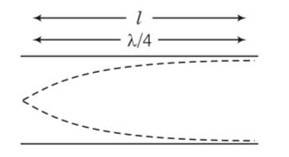Class 11th
Get insights from 8k questions on Class 11th, answered by students, alumni, and experts. You may also ask and answer any question you like about Class 11th
Follow Ask QuestionQuestions
Discussions
Active Users
Followers
New answer posted
5 months agoContributor-Level 10
This is a short answer type question as classified in NCERT Exemplar
Given frequency of the wave v=256Hz
T=
(a) time taken to pass through mean position is
t=T/4=1/40 =3.9 9.8 10-4s
(b) nodes are A, B, C, D, E (having zero displacement)
antinodes are A' and C' (having maximum displacement)
(c) it is clear from diagram A' and C' are forming antinodes have separation= v/v'=360/256=1.41m
New answer posted
5 months agoContributor-Level 10
This is a short answer type question as classified in NCERT Exemplar
We have to observe the displacement and position of different points, then accordingly nature of two waves decided
Points on positions x= 10,20,30,40 never move, always at mean position with respect to time . these are forming nodes which forms a stationary wave
Distance between two successive nodes =
node to node distance)
=2 (20-10)
= 2 (10)=20cm
New answer posted
5 months agoContributor-Level 10
This is a short answer type question as classified in NCERT Exemplar
As the source is moving towards the observer hence apparent frequency observed is more than the natural frequency
Frequency of whistle
Speed of train = vt= 10m/s
Velocity of sound in air =v= 330m/s
Apparent frequency when source is moving vapp= (v/v-vt)v
= (
=
New answer posted
5 months agoContributor-Level 10
This is a short answer type question as classified in NCERT Exemplar
length of pipe

L=20cm =20
=3
Hence 3rd harmonic node of the pipe is resonantly excited by the source of the given frequency.
New answer posted
5 months agoContributor-Level 10
This is a short answer type question as classified in NCERT Exemplar
Given that length of wire l=12m
Mass of the wire m=2.10kg
T= 2.06
Speed of transverse wave v= =
New answer posted
5 months agoContributor-Level 10
This is a short answer type question as classified in NCERT Exemplar
Let n1>n2 beat frequency
As we know time per beats = 1/frequency
Time period beats = Tb= 1/
New answer posted
5 months agoContributor-Level 10
This is a short answer type question as classified in NCERT Exemplar
we know the speed of air v
3/1 =
TT=273
=2457-273=2184 oC
New answer posted
5 months agoContributor-Level 10
This is a short answer type question as classified in NCERT Exemplar
Frequency of vibrations produced by a stretched wire
Mass per unit length = mass/length =
so when radius is tripled v will be 1/3 rd of previous value.
New answer posted
5 months agoContributor-Level 10
This is a short answer type question as classified in NCERT Exemplar
Displacement of an elastic wave y =3sinwt+4coswt
3= acos
4=asin
On dividing above equation
tan =4/3
a2cos2 +a2sin2 = 32+42
a2 (cos2 )=25
a2.1=25
a=5
Y= 5cos +5sin
= 5 [cos ]=5sin (wt+ )
Hence amplitude =5cm
New answer posted
5 months agoContributor-Level 10
This is a short answer type question as classified in NCERT Exemplar
Frequency of tuning fork A
Hz
Probable frequency of tuning fork B
Hz or 507Hz
When B is loaded its frequency reduces .
If it is 517Hz it might reduced to 507Hz given again a beat of 5Hz
If it 507Hz reduction will always increase the beat frequency, hence Hz
Taking an Exam? Selecting a College?
Get authentic answers from experts, students and alumni that you won't find anywhere else
Sign Up on ShikshaOn Shiksha, get access to
- 65k Colleges
- 1.2k Exams
- 679k Reviews
- 1800k Answers


